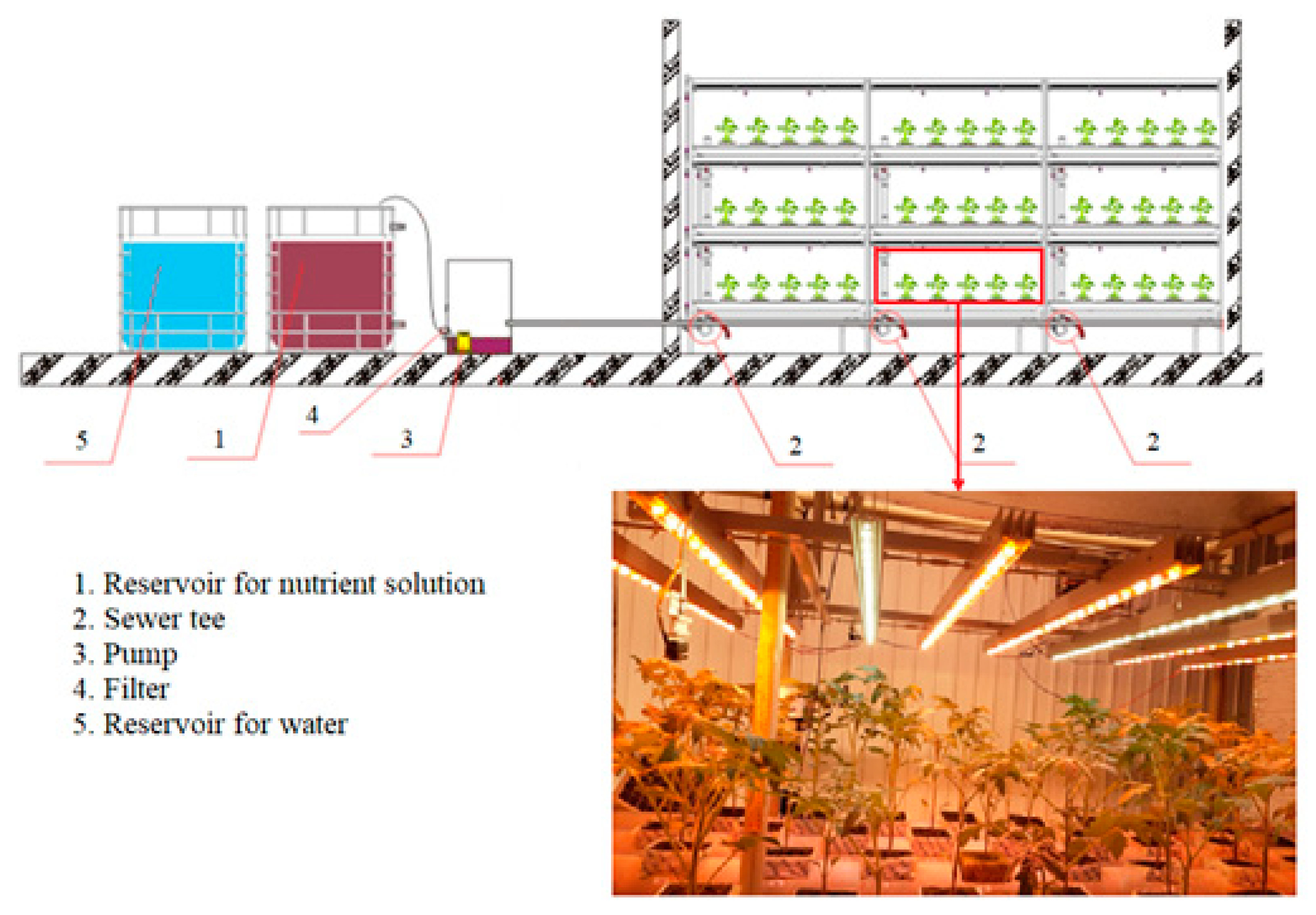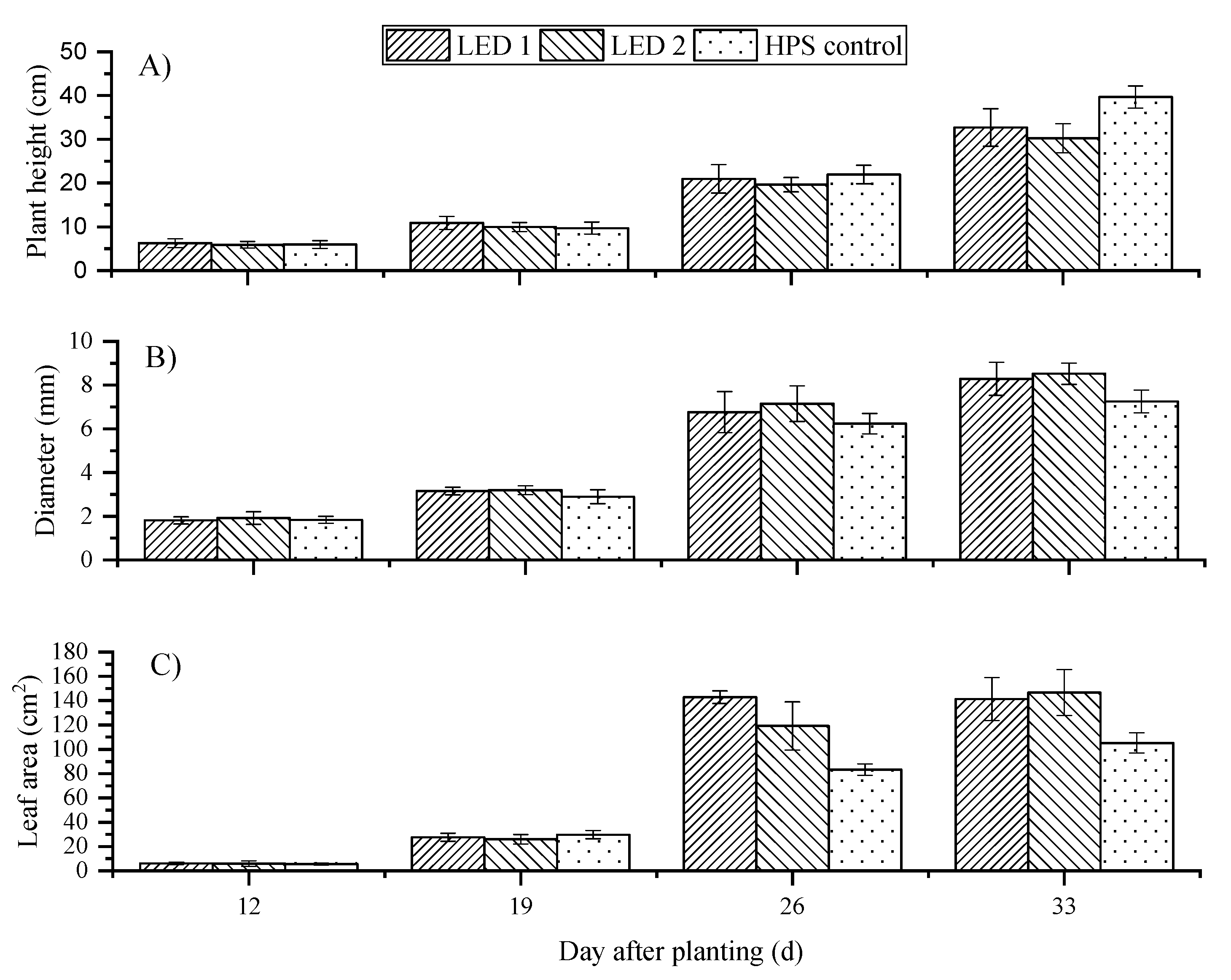The Efficiency of LED Irradiation for Cultivating High-Quality Tomato Seedlings
Abstract
1. Introduction
2. Materials and Methods
2.1. Plant Material and Growing Conditions
2.2. Experimental Facility
2.3. Analysis of Growth Parameters and Biomass of Plants
2.4. Statistical Analysis
3. Results and Discussion
3.1. Environmental Conditions during the Experiment
3.2. Morphological Analysis and Biometrical Parameters
4. Conclusions
Author Contributions
Funding
Institutional Review Board Statement
Informed Consent Statement
Data Availability Statement
Conflicts of Interest
References
- Dou, H.; Niu, G.; Gu, M.; Masabni, J. Effects of Light Quality on Growth and Phytonutrient Accumulation of Herbs under Controlled Environments. Horticulturae 2017, 3, 36. [Google Scholar] [CrossRef]
- Tamulaitis, G.; Duchovskis, P.; Bliznikas, Z.; Breive, K.; Ulinskaite, R.; Brazaityte, A.; Novičkovas, A.; Žukauskas, A. High-power light-emitting diode based facility for plant cultivation. J. Phys. D Appl. Phys. 2005, 38, 3182–3187. [Google Scholar] [CrossRef]
- Bourget, C.M. An Introduction to Light-emitting Diodes. HortScience 2008, 43, 1944–1946. [Google Scholar] [CrossRef]
- Teixeira, R.T. Distinct Responses to Light in Plants. Plants 2020, 9, 894. [Google Scholar] [CrossRef] [PubMed]
- Fan, X.-X.; Xu, Z.-G.; Liu, X.-Y.; Tang, C.-M.; Wang, L.-W.; Han, X. Effects of light intensity on the growth and leaf development of young tomato plants grown under a combination of red and blue light. Sci. Hortic. Amst. 2013, 153, 50–55. [Google Scholar] [CrossRef]
- Kim, H.; Hwang, S. The Growth and Development of ‘Mini Chal’ Tomato Plug Seedlings Grown under Various Wavelengths Using Light Emitting Diodes. Agronomy 2019, 9, 157. [Google Scholar] [CrossRef]
- Kozai, T.; Fujiwara, K.; Runkle, E.S. LED Lighting for Urban Agriculture; Kozai, T., Fujiwara, K., Runkle, E.S., Eds.; Springer Singapore: Singapore, 2016; ISBN 978-981-10-1846-6. [Google Scholar]
- Morrow, R.C. LED Lighting in Horticulture. HortScience 2008, 43, 1947–1950. [Google Scholar] [CrossRef]
- Viršilė, A.; Olle, M.; Duchovskis, P. LED Lighting in Horticulture. In Light Emitting Diodes for Agriculture; Springer: Singapore, 2017; pp. 113–147. ISBN 9789811058073. [Google Scholar]
- Tanaka, Y. A novel regulatory role of glucose transporter of Escherichia coli: Membrane sequestration of a global repressor Mlc. EMBO J. 2000, 19, 5344–5352. [Google Scholar] [CrossRef]
- Miliauskienė, J.; Karlicek, R.F.; Kolmos, E. Effect of Multispectral Pulsed Light-Emitting Diodes on the Growth, Photosynthetic and Antioxidant Response of Baby Leaf Lettuce (Lactuca sativa L.). Plants 2021, 10, 762. [Google Scholar] [CrossRef]
- Urrestarazu, M.; Nájera, C.; del Gea, M.M. Effect of the Spectral Quality and Intensity of Light-emitting Diodes on Several Horticultural Crops. HortScience 2016, 51, 268–271. [Google Scholar] [CrossRef]
- Du, P.; Gao, L.; Tang, J. Focus on performance of perovskite light-emitting diodes. Front. Optoelectron. 2020, 13, 235–245. [Google Scholar] [CrossRef]
- Meiramkulova, K.; Devrishov, D.; Marzanov, N.; Marzanova, S.; Kydyrbekova, A.; Uryumtseva, T.; Tastanova, L.; Mkilima, T. Performance of Graphite and Titanium as Cathode Electrode Materials on Poultry Slaughterhouse Wastewater Treatment. Materials 2020, 13, 4489. [Google Scholar] [CrossRef] [PubMed]
- Novokhatin, V.V.; Dragavtsev, V.A.; Leonova, T.A.; Shelomentseva, T.B. Creation of a Spring Soft Wheat Variety Grenada with the Use of Innovative Breeding Technologies Based on the Original Theory of Eco-Genetic Arrangement of Quantitative Traits. Sel’skokhozyaistvennaya Biol. 2019, 54, 905–919. [Google Scholar] [CrossRef]
- Tomsone, L.; Kruma, Z. Spectrophotometric analysis of pigments in horseradish by using various extraction solvents. In Proceedings of the 13th Baltic Conference on Food Science and Technology “Food. Nutrition. Well-Being”, FOODBALT 2019, Jelgava, Latvia, 2–3 May 2019; pp. 210–215. [Google Scholar]
- Pacheco, A.B.; Nascimento, J.G.; Moura, L.B.; Lopes, T.R.; Duarte, S.N.; Coelho, R.D.; Marques, P.A.A. Non-destructive and Destructive Methods to Determine the Leaf Area of Zucchini. J. Agric. Stud. 2020, 8, 295. [Google Scholar] [CrossRef][Green Version]
- Promratrak, L. The effect of using LED lighting in the growth of crops hydroponics. Int. J. Smart Grid Clean Energy 2017, 6, 133–140. [Google Scholar] [CrossRef]
- Gómez, C.; Gennaro Izzo, L. Increasing efficiency of crop production with LEDs. AIMS Agric. Food 2018, 3, 135–153. [Google Scholar] [CrossRef]
- Scarano, A.; Olivieri, F.; Gerardi, C.; Liso, M.; Chiesa, M.; Chieppa, M.; Frusciante, L.; Barone, A.; Santino, A.; Rigano, M.M. Selection of tomato landraces with high fruit yield and nutritional quality under elevated temperatures. J. Sci. Food Agric. 2020, 100, 2791–2799. [Google Scholar] [CrossRef]
- Jun, H.; Imai, K.; Suzuki, Y. Effects of day temperature on gas exchange characteristics in tomato ecotypes. Sci. Hortic. Amst. 1990, 42, 321–327. [Google Scholar] [CrossRef]
- Peet, M.M.; Sato, S. Comparing Pre- and Post-pollen Production Temperature Stress on Fruit Set and Fruit Production in Male-Sterile and Male-Fertile Tomatoes. HortScience 1997, 32, 526C. [Google Scholar] [CrossRef]
- Meng, Z.; Duan, A.; Chen, D.; Dassanayake, K.B.; Wang, X.; Liu, Z.; Liu, H.; Gao, S. Suitable indicators using stem diameter variation-derived indices to monitor the water status of greenhouse tomato plants. PLoS ONE 2017, 12, e0171423. [Google Scholar] [CrossRef]
- Baek, S.; Jeon, E.; Park, K.S.; Yeo, K.-H.; Lee, J. Monitoring of Water Transportation in Plant Stem with Microneedle Sap Flow Sensor. J. Microelectromech. Syst. 2018, 27, 440–447. [Google Scholar] [CrossRef]
- Gómez, C.; Mitchell, C.A. Growth Responses of Tomato Seedlings to Different Spectra of Supplemental Lighting. HortScience 2015, 50, 112–118. [Google Scholar] [CrossRef]
- Xiao, Y.L.; Shi, R.G.; Zhi, G.X.; Xue, L.J.; Tezuka, T. Regulation of Chloroplast Ultrastructure, Cross-section Anatomy of Leaves, and Morphology of Stomata of Cherry Tomato by Different Light Irradiations of Light-emitting Diodes. HortScience 2011, 46, 217–221. [Google Scholar] [CrossRef]
- Ying, Q.; Kong, Y.; Zheng, Y. Applying Blue Light Alone, or in Combination with Far-red Light, during Nighttime Increases Elongation without Compromising Yield and Quality of Indoor-grown Microgreens. HortScience 2020, 55, 876–881. [Google Scholar] [CrossRef]
- Wei, H.; Xiao, X.W.; Min, P.; Xiao, Y.L.; Lijun, G.; Zhi, G.X. Effect different spectral LED on photosynthesis and distribution of photosynthate of cherry tomato seedlings. In Proceedings of the 2017 14th China International Forum on Solid State Lighting: International Forum on Wide Bandgap Semiconductors China (SSLChina: IFWS), Beijing, China, 1–3 November 2017; pp. 78–84. [Google Scholar]
- Ayliffe, M.; Periyannan, S.K.; Feechan, A.; Dry, I.; Schumann, U.; Wang, M.-B.; Pryor, A.; Lagudah, E. A Simple Method for Comparing Fungal Biomass in Infected Plant Tissues. Mol. Plant Microbe Interact. 2013, 26, 658–667. [Google Scholar] [CrossRef]
- Šesták, Z. Limitations for finding a linear relationship between chlorophyll content and photosynthetic activity. Biol. Plant. 1966, 8, 336–346. [Google Scholar] [CrossRef]
- Kitao, M.; Hayashi, T.; Tomi, K. Effects of Changes in Light Quality on the Aroma Chemotype of Roman Chamomile. Acta Hortic. 2013, 75–80. [Google Scholar] [CrossRef]
- Son, M.; Pinnola, A.; Gordon, S.C.; Bassi, R.; Schlau-Cohen, G.S. Observation of dissipative chlorophyll-to-carotenoid energy transfer in light-harvesting complex II in membrane nanodiscs. Nat. Commun. 2020, 11, 1295. [Google Scholar] [CrossRef] [PubMed]
- Ramel, F.; Birtic, S.; Cuiné, S.; Triantaphylidès, C.; Ravanat, J.-L.; Havaux, M. Chemical Quenching of Singlet Oxygen by Carotenoids in Plants. Plant Physiol. 2012, 158, 1267–1278. [Google Scholar] [CrossRef]
- Dovlatov, I.M. Absorption of the Spectrum of Ultraviolet Radiation by Various Cultures. Elektrotekhnologii Elektrooborud. APK 2020, 67, 14–20. [Google Scholar] [CrossRef]
- Xu, H.; Fu, Y.; Li, T.; Wang, R. Effects of different LED light wavelengths on the resistance of tomato against Botrytis cinerea and the corresponding physiological mechanisms. J. Integr. Agric. 2017, 16, 106–114. [Google Scholar] [CrossRef]



| Treatments | LED Lights | Photon Flux Density (PPFD), μmolm−2s−1 | Wavelength (nm) |
|---|---|---|---|
| LED lighting 1 (LED-1) | Red light-emitting diodes (LEDs, R) | 100 |  |
| LED lighting 2 (LED-2) | Blue, Green, Yellow, Red light-emitting diodes (LEDs, B, G, Y, R) | 180 |  |
| High-pressure sodium arc lamp (HPS control) | Yellow light-emitting diodes (LEDs, Y) | 80 |  |
| LED Lights Treatments (molm−2 s−1) | Dry Weight (g) | Fresh Weight (g) | Plant Height (cm) | Stem Diameter (mm) | Leaf Area (cm2) | Health Index |
|---|---|---|---|---|---|---|
| LED-1 | 6.03 a | 44.13 a | 32.69 b | 8.29 a | 151.34 a | 1.53 a |
| LED-2 | 4.98 ab | 37.21 b | 30.25 b | 8.52 a | 163.38 a | 1.4 a |
| HPS control | 4.22 b | 36.45 b | 39.69 a | 7.25 b | 93.57 b | 0.77 b |
| LED Lights Treaments (molm−2 s−1) | Chla (mg·g−1) | Chlb (mg·g−1) | Chl(a + b) (mg·g−1) | Chla/b | Carotenoid (mg·g−1) |
|---|---|---|---|---|---|
| LED-1 | 0.739 a | 0.447 a | 1.186 a | 1.653 a | 0.148 a |
| LED-2 | 0.665 a | 0.388 a | 1.015 ab | 1.917 a | 0.128 b |
| HPS control | 0.564 b | 0.285 b | 0.849 b | 1.989 a | 0.111 c |
Publisher’s Note: MDPI stays neutral with regard to jurisdictional claims in published maps and institutional affiliations. |
© 2021 by the authors. Licensee MDPI, Basel, Switzerland. This article is an open access article distributed under the terms and conditions of the Creative Commons Attribution (CC BY) license (https://creativecommons.org/licenses/by/4.0/).
Share and Cite
Meiramkulova, K.; Tanybayeva, Z.; Kydyrbekova, A.; Turbekova, A.; Aytkhozhin, S.; Zhantasov, S.; Taukenov, A. The Efficiency of LED Irradiation for Cultivating High-Quality Tomato Seedlings. Sustainability 2021, 13, 9426. https://doi.org/10.3390/su13169426
Meiramkulova K, Tanybayeva Z, Kydyrbekova A, Turbekova A, Aytkhozhin S, Zhantasov S, Taukenov A. The Efficiency of LED Irradiation for Cultivating High-Quality Tomato Seedlings. Sustainability. 2021; 13(16):9426. https://doi.org/10.3390/su13169426
Chicago/Turabian StyleMeiramkulova, Kulyash, Zhanar Tanybayeva, Assel Kydyrbekova, Arysgul Turbekova, Serik Aytkhozhin, Serik Zhantasov, and Aman Taukenov. 2021. "The Efficiency of LED Irradiation for Cultivating High-Quality Tomato Seedlings" Sustainability 13, no. 16: 9426. https://doi.org/10.3390/su13169426
APA StyleMeiramkulova, K., Tanybayeva, Z., Kydyrbekova, A., Turbekova, A., Aytkhozhin, S., Zhantasov, S., & Taukenov, A. (2021). The Efficiency of LED Irradiation for Cultivating High-Quality Tomato Seedlings. Sustainability, 13(16), 9426. https://doi.org/10.3390/su13169426






